Indian Pale Ale
I had some colleagues from India visit on a work trip in early September. Of course, when they asked what I would like them to bring from India, I requested spices… for brewing. This presents the perfect opportunity to make an IndiaN pale ale! How could I pass it up? I must admit, I’m not very knowledgeable regarding Indian cuisine so I had my brew club help draft a list of requests based on their culinary experience. Here is everything I received:
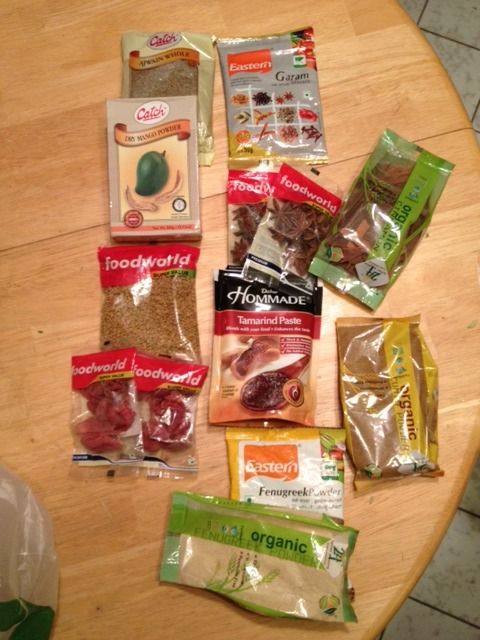
Since the hop harvest/brew day timing didn’t quite work out this year, I ended up drying all the hops I picked. In effect, I’m sort of combining my hop harvest pale ale into this Indian-spiced concoction of a brew day this year. However, I am still playing it safe. No spices will be added until secondary fermentation and I think I will buy smaller secondary fermenters to split the batch in half, dry-hopping both but only spicing one. This way I’ll still have some unadulterated homegrown hopped IPA and not too much spiced beer (incase it turns out over-spiced). Haven’t quite decided what spice I will add yet, but I’m leaning towards just the amchoor powder (dried mango). I’m thinking it could add a complimentary citrus/fruity note.
Here’s the base recipe (grain bill from Brewing Classic Styles, hops dictated by my homegrown supply, save for the magnum bittering addition I had lying around) and pics from the 10/7/12 brew day: (more…)
First batch of cider
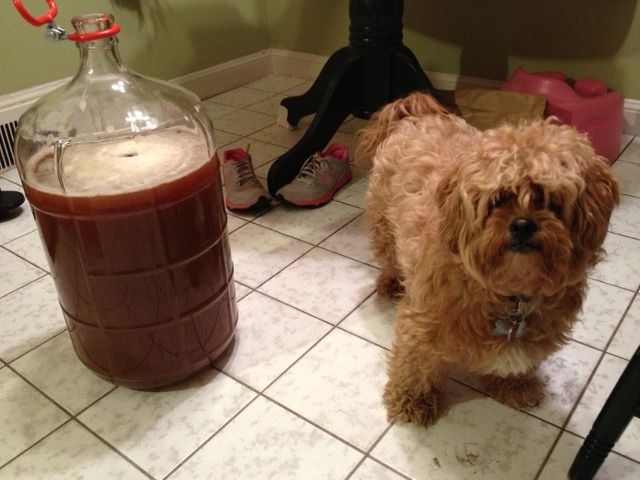 Inspired by a recent cider-centric BrewingTV episode, I managed to get a contact through my homebrew club in September for some homemade cider. The guy has seven apple trees in his Victoria, MN backyard and had pressed the cider the very same day I picked it up, drove home and began the fermentation process. Can’t get much fresher than that! $25 for 5 gallons. Happy to pay that price, especially because the guy made it himself. The batch I picked was a blend of Macintosh and Prairie Spy apples.
Inspired by a recent cider-centric BrewingTV episode, I managed to get a contact through my homebrew club in September for some homemade cider. The guy has seven apple trees in his Victoria, MN backyard and had pressed the cider the very same day I picked it up, drove home and began the fermentation process. Can’t get much fresher than that! $25 for 5 gallons. Happy to pay that price, especially because the guy made it himself. The batch I picked was a blend of Macintosh and Prairie Spy apples.
I hadn’t done much research on making hard cider prior to the BrewingTV episode and was pleasantly surprised at how easy this is compared to all-grain (and even extract) brewing. No boiling involved! Here’s the process: (more…)
CUJO SPICE 3.0 pumpkin helles lager
 For my annual fall pumpkin beer this year, I decided to switch up the base recipe. In 2011 I did a rye ale base and in 2010 I did just a basic amber/pale ale base. 2012 is the year of the lager for me (#2012!), so I opted to do a helles base. Thought it would set a decent, unobtrusive stage for the pumpkin to shine through. Also, pumpkin… halloween… hell-es… Sounded appropriate.
For my annual fall pumpkin beer this year, I decided to switch up the base recipe. In 2011 I did a rye ale base and in 2010 I did just a basic amber/pale ale base. 2012 is the year of the lager for me (#2012!), so I opted to do a helles base. Thought it would set a decent, unobtrusive stage for the pumpkin to shine through. Also, pumpkin… halloween… hell-es… Sounded appropriate.
I brewed this on 8/26, back when it was still relatively warm out. It was really tough to get the wort down to lager pitching temp (low 50’s). My ground water+immersion chiller only took it to 78°F, after which I transferred to the fermenter and let it cool further in the fridge. I woke up by happenstance at around 2:00am (5 hrs. after putting the fermenter in the fridge) and the temp had made it to the low 50’s, so I pitched at that time. When I woke up the next morning, the temp had continued to drop all the way down to the mid-low 40’s. Oops! I turned the temperature regulator up further on the fridge and brought the temp of the wort back up to the 50’s over the next day. I believe this attributed to a slow start to fermentation. All in all, it took nearly 36 hrs. for visible signs of fermentation to show. Something I’ll make sure to do better in the future is to calibrate the temp of my chest fridge/freezer further ahead of time when I plan to ferment in there. For this brew day, I didn’t turn up the temp until I started brewing. I really should allot 48 hrs. to accurately move the temp from 37°F (where it generally sits) up to the low 50’s for lager fermentation.
Here’s the recipe (based on Jamil’s helles in Brewing Classic Styles):
SaiSon of a bitch (SOB) 2.1
I recently whipped up another batch of S.O.B., as my neighborhood drank most of the first at our National Night Out block party in August. There were only minor changes made from the first batch. More table sugar to further promote a dry finish and some alcohol heft, an ounce more caramunich and some year-old homegrown Cascade hops as part of the bittering addition (as opposed to the year-old homegrown Hallertau hops I used at this step in the first version).
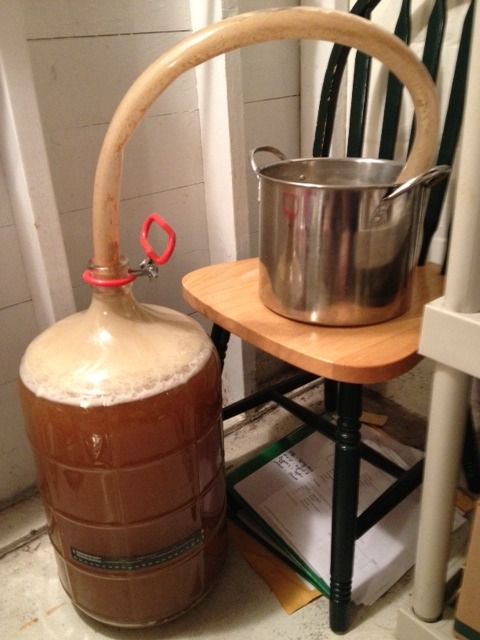 Man, I love WLP566 Belgian Saison II. The attenuation level is quite high and it begins working very soon (two hours?) after pitch. I left this one in primary for 12 days but almost all of the fermentation activity was done within seven. Enjoyed the first pint 19 days after brew day, which was a bit longer than the fist batch (16 days) but that was intentional, as I had more time to leave this one in primary to ensure it fermented as dry as possible.
Man, I love WLP566 Belgian Saison II. The attenuation level is quite high and it begins working very soon (two hours?) after pitch. I left this one in primary for 12 days but almost all of the fermentation activity was done within seven. Enjoyed the first pint 19 days after brew day, which was a bit longer than the fist batch (16 days) but that was intentional, as I had more time to leave this one in primary to ensure it fermented as dry as possible.
This might be my most favorite beer I’ve made. I love the style, love the yeast, love how it turned out (twice in a row!). Yes, Saison is my favorite summer beer by far. Here’s the recipe: (more…)
Dry humor…
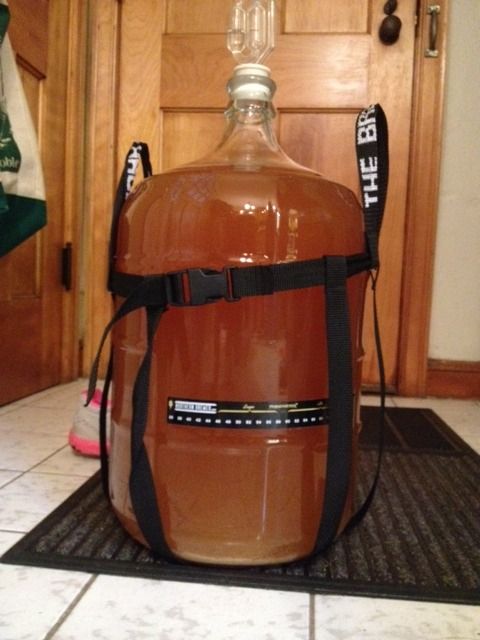 Have you ever had a saison that was too dry? I just took a refract reading while transferring my SOB 2.0 to secondary after 9 days at 72 ramped up to 78 degrees. Mash target was 147 but ended up being between 143-146. 1 lb table sugar in a 12.5 lb grain bill batch…
Have you ever had a saison that was too dry? I just took a refract reading while transferring my SOB 2.0 to secondary after 9 days at 72 ramped up to 78 degrees. Mash target was 147 but ended up being between 143-146. 1 lb table sugar in a 12.5 lb grain bill batch…
The refractometer wouldn’t register! At all! There isnt a reading to correct off of (if I assume it’s straight zero and a 1.055 OG, that puts me at 0.97 after correcting for alcohol and temp, and roughly 7.3% ABV). It’s basically telling me there is no sugar left. It all fermented. Upon tasting, I’d agree. I was hoping it’d end at like 1.005 or something, was aggressive in trying to ensure the batch would be dry because I’d read that too much body in saisons is the most common flaw. I succeeded, and then some. It’s spicy and almost evaporates off the tongue… (more…)
SaiSon of a bitch (SOB) 2.0
 It’s been a HOT and busy summer in Minnesota. Par for the course, I guess. I’ve either playing shows with the band or hanging with my wife and daughter. I haven’t brewed since I did a double brew day back on 5/12 (wheat and oktoberfest). It was about time to find a day again to get something new going. I decided to do a saison on 7/22. This is the second saison I’ve ever made and will be named after the first, SaiSon of a bitch. I love this style. My favorite summer beer by far. The hot weather is well attuned to fermenting this style of beer as well, which definitely went into consideration when selecting this style.
It’s been a HOT and busy summer in Minnesota. Par for the course, I guess. I’ve either playing shows with the band or hanging with my wife and daughter. I haven’t brewed since I did a double brew day back on 5/12 (wheat and oktoberfest). It was about time to find a day again to get something new going. I decided to do a saison on 7/22. This is the second saison I’ve ever made and will be named after the first, SaiSon of a bitch. I love this style. My favorite summer beer by far. The hot weather is well attuned to fermenting this style of beer as well, which definitely went into consideration when selecting this style.
The brew day went reasonably well. The biggest mistake I made was leaving the kitchen while I was filling a bucket with sanitizer and water. I have these clamps that hook onto the sprayer and let me multi-task. I went outside to do who knows what and forgot I was filling the bucket. When I came back in there was a quarter inch of water all over my kitchen floor. I ran for the sink and slipped on the water, banging my knee hard against the cabinet. This all happened with about 20 min. left in the 90 min. boil. It took me an extra 15 min. to clean up my kitchen as fast as I could, turning a 90 min. boil into a 105, which is what you’ll see noted in the boil schedule below. What were supposed to be 60 min. additions turned into 75. (more…)
Fraz(zled) Wheat 3.0
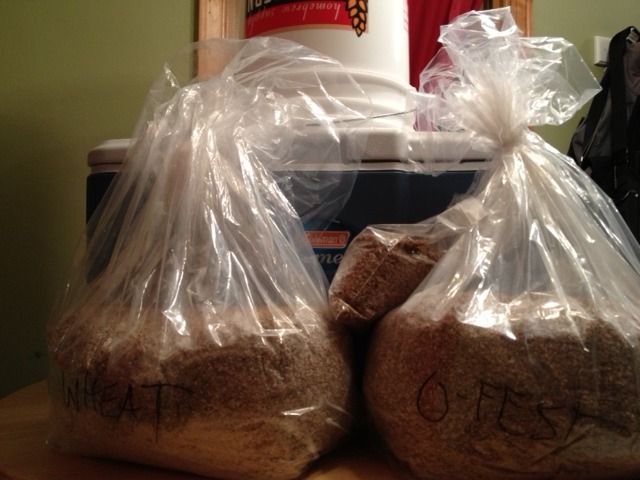 Back by popular demand for the third year in a row, I crammed in a double brew day back in May so I could have some Fraz(zled) Wheat raspberry hefeweizen on hand for the coming summer months. Though last year’s 2.0 version didn’t do so hot in competition (“too much raspberry flavor overpowers the base style”), it sure was greatly appreciated by anyone who was able to snag a bottle. This is the only seasonal brew I’ve done each year I’ve been brewing, starting off as an extract version in 2010, moving to all-grain in 2011 and of course again this year as well.
Back by popular demand for the third year in a row, I crammed in a double brew day back in May so I could have some Fraz(zled) Wheat raspberry hefeweizen on hand for the coming summer months. Though last year’s 2.0 version didn’t do so hot in competition (“too much raspberry flavor overpowers the base style”), it sure was greatly appreciated by anyone who was able to snag a bottle. This is the only seasonal brew I’ve done each year I’ve been brewing, starting off as an extract version in 2010, moving to all-grain in 2011 and of course again this year as well.
I tried a new base hefeweizen recipe for Fraz Wheat this year, taken directly from the book Brewing Classic Styles by John Palmer and Jamil Zainasheff: (more…)
Osktoberfest
 Though my dog Leinenkugel gets most of the attention on this blog as Barking Dog Beer’s official mascot, what better time to give my other dog Oscar a shout-out than while naming my first attempt at an oktoberfest bier. Thus, “Osktoberfest” was conceived.
Though my dog Leinenkugel gets most of the attention on this blog as Barking Dog Beer’s official mascot, what better time to give my other dog Oscar a shout-out than while naming my first attempt at an oktoberfest bier. Thus, “Osktoberfest” was conceived.
The recipe I used is basically one I pulled out of Brewing Classic Styles, the book I bought from co-author John Palmer when I met him at a book signing at Northern Brewer back in April. I think the only tweak was the yeast, as I had to use a White Labs and a Wyeast O-fest strain because Northern Brewer only had one White Labs O-fest vial left. I already know the FG on this one because I’m super behind in writing this post. I brewed this batch on May 12th, same day I brewed a hefeweizen, hence the two different types you see in the adjacent pic.
Here’s the recipe: (more…)
The barrel is full
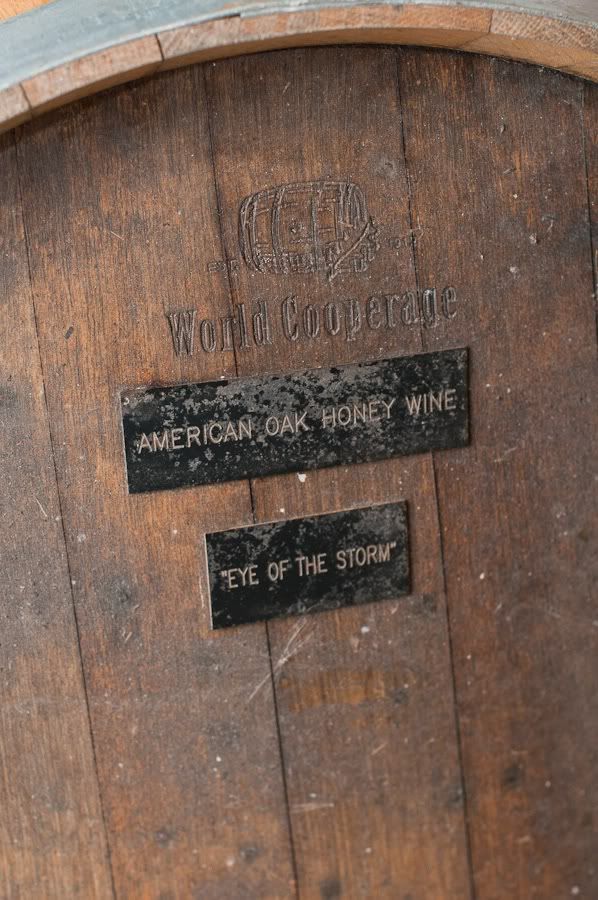 And thus commences the souring of the beer. 14 members of my brew club, the Nordeast Brewers Alliance, got together on 4/28 and filled the 59 gallon honey wine barrel with the sum of our collective brews (the recipe we all used is found in a prior post here and here is a post on the entire project). The collective FG on 4/28 was 1.013, so there is a decent number of fermentable sugars for the bugs to feast on as well as plenty of long-chain sugars left over from everyone employing a higher mash temperature. We pitched a huge slurry of beer-souring bacteria Nick has collected and propagated over time as well as fresh dregs from sour beers we were drinking that afternoon (New Belgium’s La Follie, Lindemans Cuvee Rene, Surly 5, a handful of Jolly Pumpkin brews and others I can’t recall).
And thus commences the souring of the beer. 14 members of my brew club, the Nordeast Brewers Alliance, got together on 4/28 and filled the 59 gallon honey wine barrel with the sum of our collective brews (the recipe we all used is found in a prior post here and here is a post on the entire project). The collective FG on 4/28 was 1.013, so there is a decent number of fermentable sugars for the bugs to feast on as well as plenty of long-chain sugars left over from everyone employing a higher mash temperature. We pitched a huge slurry of beer-souring bacteria Nick has collected and propagated over time as well as fresh dregs from sour beers we were drinking that afternoon (New Belgium’s La Follie, Lindemans Cuvee Rene, Surly 5, a handful of Jolly Pumpkin brews and others I can’t recall).
Now… we wait. The plan is to take a sample 6 months from now (Halloween!) and every consecutive 3 months thereafter until we’re satisfied with how it has soured and matured to pull each of our five gallons back out to do with as we please. Along the way, we’ll likely need another five to ten gallons more to syphon into the barrel to account for evaporation, which may be a good opportunity to add beer that’ll pump up the body of the final product if needed. Nick has some ideas about adding beer made with a higher than normal percentage of oats to thicken it all up. Should be interesting when it’s completed!
Most of the pics featured in this post were taken by club member Daniel Snow, professional photographer. I think they look awesome. Check ’em out: (more…)
The California Common is shaping up
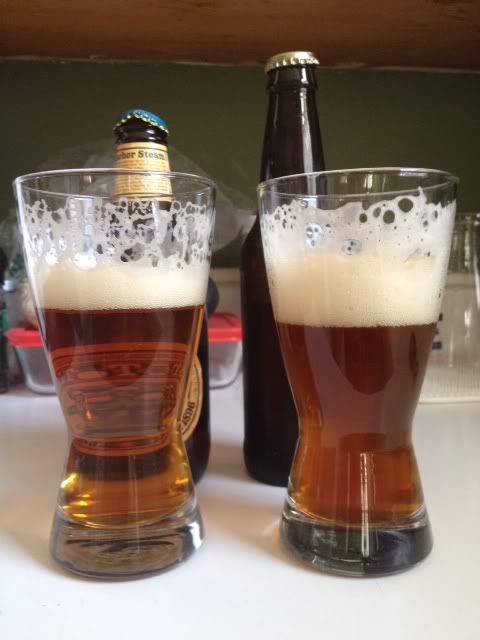 I bottled my California Common steam beer back on 3/31 (Golden Gate Retriever) and cracked the first bottle three weeks later. I think it was a bit early, as I thought I sensed a trace amount of acetaldehyde green apple flavor. I haven’t had a problem with this off-flavor much in the past. Acetaldehyde is usually found in beer that was racked from primary fermentation too early, not giving the yeast time to clean up this off-flavor they create during the process. I looked back at my fermentation schedule and it was in primary for 20 days (plenty of time!) at temps of 55-58*, which I’d think would be the culprit if this weren’t fermented with WLP-810 San Francisco lager yeast. In reading the description on White Labs’ site, I guess they say the optimum fermentation temp for this strain is 58-65*, so I might have been a bit under the optimum fermentation temp which may have inhibited the yeast from cleaning up after themselves…
I bottled my California Common steam beer back on 3/31 (Golden Gate Retriever) and cracked the first bottle three weeks later. I think it was a bit early, as I thought I sensed a trace amount of acetaldehyde green apple flavor. I haven’t had a problem with this off-flavor much in the past. Acetaldehyde is usually found in beer that was racked from primary fermentation too early, not giving the yeast time to clean up this off-flavor they create during the process. I looked back at my fermentation schedule and it was in primary for 20 days (plenty of time!) at temps of 55-58*, which I’d think would be the culprit if this weren’t fermented with WLP-810 San Francisco lager yeast. In reading the description on White Labs’ site, I guess they say the optimum fermentation temp for this strain is 58-65*, so I might have been a bit under the optimum fermentation temp which may have inhibited the yeast from cleaning up after themselves…
Fortunately, the yeast appear to be cleaning up the small amounts of acetaldehyde in the bottle over time. The green apple flavor has dissipated over the past week of bottle conditioning since I opened the first bottle. It’s getting clearer at lower temperatures too. This drinkable 4.5% brew will be one of the two I may compete in my brew club’s summer <6% beer competition. We’ll see if it’s better than the Belgian Pale Ale I’m working on, which should clock in at 5.5%. (more…)
Sour beer flocculation
It was kinda cool to watch the WLP-510 Bastogne ale yeast flocculate out of the sour beer (11 lbs. modified pilsner, 2 lbs malted wheat) recipe as ferment completed. It changed color in a definitive manner three pronounced times. After pitch to primary fermentation color, primary fermentation color to a darker color once transferred to secondary and finally a slightly darker color (and clearer) yet again a week after being transferred to secondary. The pics below were taken over a few days during the second of the three pronounced changes. Check it out:
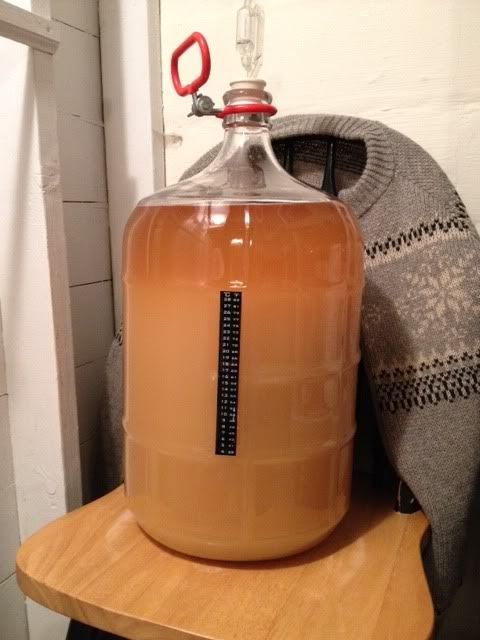
Going lower… (more…)
Malinois Pale Ale
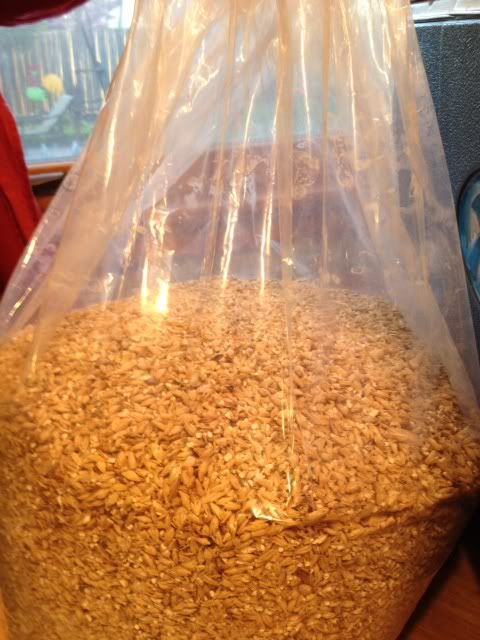 I threw together a brew day at the behest of the wife this past weekend as she was going to be busy with other stuff. Not a problem! I just moved up my plans to brew a Belgian pale ale by a few weeks (named after a popular Belgian sheep dog, the Malinois). This will be one of the two beers I’m going to choose from to compete in my homebrew club’s summer competition (the other being the California Common I brewed last month).
I threw together a brew day at the behest of the wife this past weekend as she was going to be busy with other stuff. Not a problem! I just moved up my plans to brew a Belgian pale ale by a few weeks (named after a popular Belgian sheep dog, the Malinois). This will be one of the two beers I’m going to choose from to compete in my homebrew club’s summer competition (the other being the California Common I brewed last month).
In my recipe research, I bought a bomber of Belgian Pale Ale produced by local brewery Flat Earth and sent them an email to see if they’d be open to sharing the recipe. No response!  That’s ok, I get it. Just thought I’d try. I took another avenue and listened to a podcast by Jamil Zainasheff from 2006 where he walks through his own BPA recipe (listen here). Mine is largely based off of his. Given that the caramunich I could get was only 57*L instead of 75*L like Jamil suggested. To help compensate, I used 0.5 lbs of it instead of .75 lbs and then changed the normal 8*L munich he suggested for dark 15.5*L munich malt and then added 6 oz. of 1.8*L carafoam so I could make sure this brew has a nice sustainable head. Also, I threw in a tbsp of bitter orange in at the end of the boil to see if I could help bring out that flavor in this BPA.
That’s ok, I get it. Just thought I’d try. I took another avenue and listened to a podcast by Jamil Zainasheff from 2006 where he walks through his own BPA recipe (listen here). Mine is largely based off of his. Given that the caramunich I could get was only 57*L instead of 75*L like Jamil suggested. To help compensate, I used 0.5 lbs of it instead of .75 lbs and then changed the normal 8*L munich he suggested for dark 15.5*L munich malt and then added 6 oz. of 1.8*L carafoam so I could make sure this brew has a nice sustainable head. Also, I threw in a tbsp of bitter orange in at the end of the boil to see if I could help bring out that flavor in this BPA.
Other than that, this brew day was pretty much by-the-book. 151*-149* 75 min. mash, 90 min. boil to eliminate DMS from the pilsner malt and I’m using the WLP-510 Bastogne yeast I collected and washed from the sour beer’s primary ferment. It’s rockin’ and rollin’ as I type this! Here’s the recipe: (more…)
Barrel-aging project sour beer
 In a recent post, I discussed how members of the Nordeast Homebrewers Club are doing a sour beer project. Since my schedule will be a bit cramped in the coming weeks with the new baby, work and gigs with my band, I decided to get this brew done ASAP on 3/25 so I could ensure I’m ready to transfer this into the barrel along with everyone else’s beer near the end of April.
In a recent post, I discussed how members of the Nordeast Homebrewers Club are doing a sour beer project. Since my schedule will be a bit cramped in the coming weeks with the new baby, work and gigs with my band, I decided to get this brew done ASAP on 3/25 so I could ensure I’m ready to transfer this into the barrel along with everyone else’s beer near the end of April.
Using a batch sparge for only the second time (normally I’ve done fly spargin) and trying my hardest to speed along this pseudo-impromptu brew day, I was able to crank it out start to finish in just 6 hours (7am-1pm) with an extra half hour or more of cleanup later in the afternoon. Normally my brew days run 8 or 9 hours so I was pretty happy with my time here.
The pic to the right shows the high mash temps we’re all employing with this brew in order to leave lots of long-chain unfermentable sugars left over for the bugs to eventually eat in the barrel over the course of the coming year.
Here’s what the grist translated to at the individual recipe level: (more…)
Bottling the Maibark maibock
Got the maibock batch bottled back on 3/18 that I had brewed two months prior. I was able to have it sit out in the garage damn near freezing for five weeks in February and early March before a freak heat wave hit Minnesota. Look how clear this is!
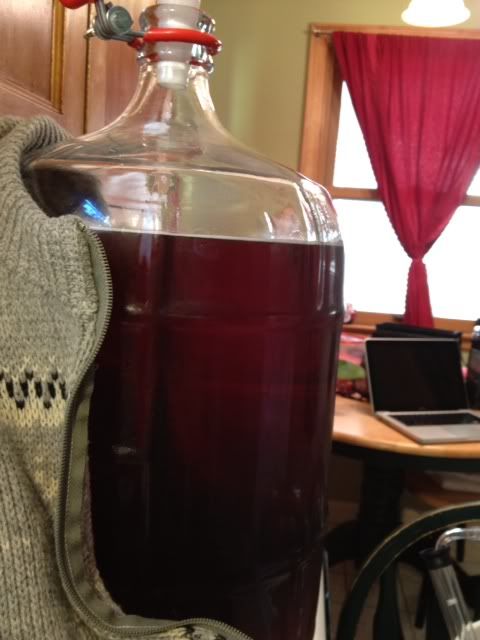
Nordeast Brewers Alliance barrel-aging sour beer project
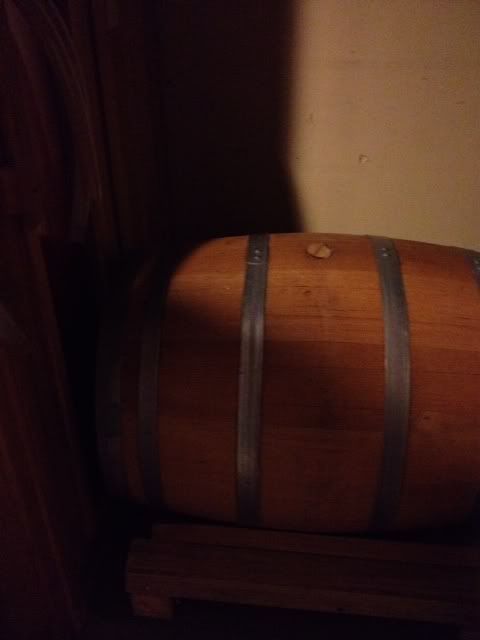 14 members of my homebrew club, the Nordeast Brewers Alliance (NBA) threw in some cash to be part of a sour beer barrel aging project, myself included. Originally we thought the money would go to purchasing the barrel, itself. We ended up finding one for free. It had been used by Town Hall Brewery for their Eye of the Storm honeywine this past winter and before that by (I believe) a vintner for a white wine, of what type I’m not sure.
14 members of my homebrew club, the Nordeast Brewers Alliance (NBA) threw in some cash to be part of a sour beer barrel aging project, myself included. Originally we thought the money would go to purchasing the barrel, itself. We ended up finding one for free. It had been used by Town Hall Brewery for their Eye of the Storm honeywine this past winter and before that by (I believe) a vintner for a white wine, of what type I’m not sure.
The huge 60 gallon barrel is graciously living at Nick’s place in Northeast Minneapolis. Everyone is aiming to have their 5 gallons fermented around the time of our April club meeting (4/21), at which time we’ll syphon it all in along with the bacteria to do the souring over the course of the next year or so. Man, it felt weird to brew this beer this past weekend knowing I wouldn’t be drinking any of it for over a year. Normally I figure I drink or give away most of my output between two and nine months from brew day. This one will have to pay off in time. Here is what Nick bought to be split up between 14 guys: (more…)
Brews in-progress
I’ve got two batches in progress right now. Four days after pitch, fermentation on my Golden Gate Retriever California Common has started to visibly slow down. Also, it’s been incredibly warm in Minnesota this week (we hit a high of something like 74* today where the record was 64*!!) so after sitting in in the garage at 38* for the last five weeks, I had to pull the Maibark Maibock batch inside last night (where it had reached nearly 60* Tuesday) and drop it down into the cellar where it’ll get no warmer than 55* until I can find time to bottle it.
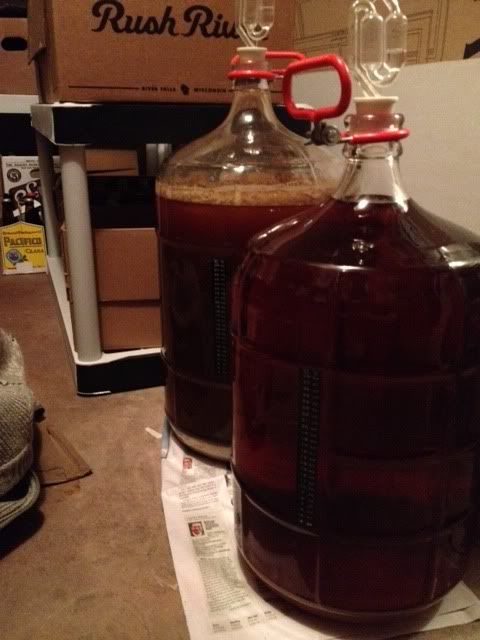
Golden Gate Retriever California Common (L) and Maibark Maibock (R)
Golden Gate Retriever
 I’ve been wanting to brew some lighter beers for the summer, notably because of the low-gravity beers competition my brew club will be having at our summer grill-out event. Coupling that motivation with the ambient temps currently in my basement (55-60*) for fermentation and my options are limited to a select few styles. Since I’d never tried my hand at a California Common or “Steam beer” before, I decided now was the time.
I’ve been wanting to brew some lighter beers for the summer, notably because of the low-gravity beers competition my brew club will be having at our summer grill-out event. Coupling that motivation with the ambient temps currently in my basement (55-60*) for fermentation and my options are limited to a select few styles. Since I’d never tried my hand at a California Common or “Steam beer” before, I decided now was the time.
This beer will definitely qualify for the aforementioned competition. With an OG of just 1.045, it’ll be one of the lightest beer I’ve ever made. Even if it ferments way down below 1.010, it’ll still struggle to come in at more than 5%. This batch was the first time I tried a true batch sparge. I don’t think it changed my efficiency much for the worse and I ended up saving at least an hour on my brew day by employing this method instead of fly sparging.
My buddy Dave was over helping on this brew day and the one to name this batch. This is the first time someone besides myself or my wife has named a batch of Barking Dog beer. Great idea Dave! Here’s the recipe: (more…)
Maibark update
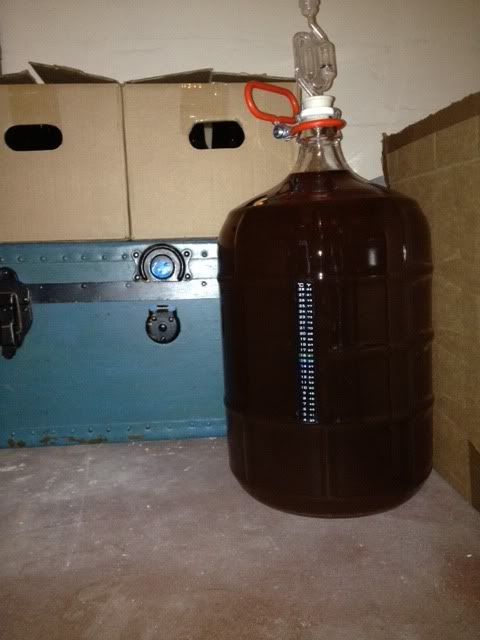 Recently, I transferred the maibock batch to a warmer room after fermentation slowed 11 days in. Within those first 11 days, it fermented for 3 to 5 days at 56* then worked it’s way down to 51* for the rest as activity slowed. I then moved the batch to a warmer room on 1/26 where it stayed for about 9 days (until 2/4/12), working it’s way from 57* to 60* for the diacetyl rest step so that the lager yeast could clean up the undesirable by-products of fermentation.
Recently, I transferred the maibock batch to a warmer room after fermentation slowed 11 days in. Within those first 11 days, it fermented for 3 to 5 days at 56* then worked it’s way down to 51* for the rest as activity slowed. I then moved the batch to a warmer room on 1/26 where it stayed for about 9 days (until 2/4/12), working it’s way from 57* to 60* for the diacetyl rest step so that the lager yeast could clean up the undesirable by-products of fermentation.
Today (2/4), I transferred the batch to secondary and will work it down to lagering temperatures over the next few days. The gravity was between 8.75 and 8.5 brix (1.016-1.015). Based on the OG of 1.067, this batch is sitting right around 7.1% ABV right now. I plan to lager it for 5 weeks, bottling it 3/10 or 3/11 so it’ll be completely bottle conditioned by May. (more…)
Maibark
I tried my hand at a maibock back on 1/15, again taking advantage of the long MLK Jr. weekend to brew this year. This is becoming a tradition. Instead of doing a double or triple decoction, I tried to select mostly well-modified malts (the vienna was recommended to be step-mashed but whatever) instead of doing a double or triple decoction as per German tradition. I did throw half a pound of melanoidin malt in the bill to emulate a little bit of the extra body I might get through decoction mashing. We’ll see how it turns out.
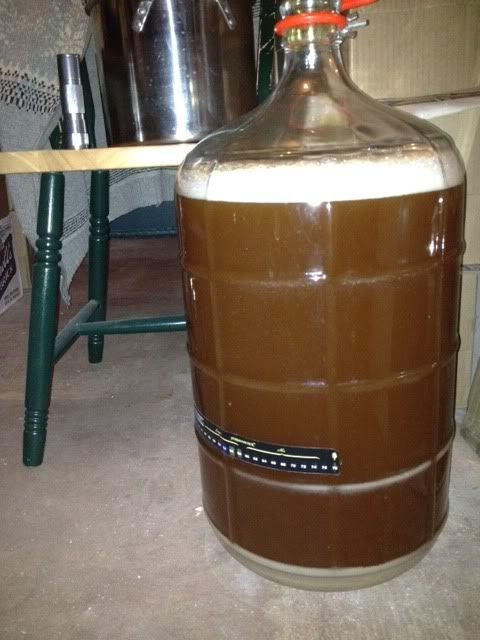
Rauch! Rauch! Rauchbier
 I brewed a rauchbier back on 12/16/11. I based my recipe off of one I found here within a rauchbier style profile BYO article. I stepped up the malt bill on mine by 50% to account for the poor efficiency of my operation (calculated recently at somewhere between 51-57%). I also increased the percentage of smoked/rauch malt. I had never had a traditional full-on rauchbier before, so I was weary of using mostly smoked malts as those recipes do, though I kinda wish I had.
I brewed a rauchbier back on 12/16/11. I based my recipe off of one I found here within a rauchbier style profile BYO article. I stepped up the malt bill on mine by 50% to account for the poor efficiency of my operation (calculated recently at somewhere between 51-57%). I also increased the percentage of smoked/rauch malt. I had never had a traditional full-on rauchbier before, so I was weary of using mostly smoked malts as those recipes do, though I kinda wish I had.
I tasted the wort prior to pitch on brew day and even with 1/4 of the grain bill being smoked malts, it didn’t taste very smokey at all. At the time I thought maybe that’ll be a good thing in the long run, but since brew day I had the chance to try a traditional exemplar of the style, Aecht Schlenkerla’s Urbock Rauchbier. This Bamberg, Germany-based brewery is one of the few that smoke their own malt via traditional methods and produce their beers mainly with these rauch malts. The smokey flavor was definitely intense, slapping you across the face in a way very similar to heavily smoked gouda. Though you’ll never find me drinking more than one or two of these intense (and expensive at $12 a bottle at Buster’s on 28th!) beers in a sitting, I liked it a lot. I hope the one I brewed turns out smokey enough, but I’m doubtful based on the taste of the wort. Next time I’ll use 100% smoked base malts. (more…)
Alba Dog

I took last Friday 11/18 off work to burn through another vacation day and brew a beer. This was the first time in a while that I’ve brewed without… purpose. In July, I did two batches of pumpkin ale for Halloween/Thanksgiving, in early October I did a hop harvest beer to try out the hops I grew this past summer, and in early November I did a Belgian honey ale for release after the birth of my daughter in February. The only purpose I had in brewing this Scotch ale was that I FREAKING LOVE SCOTCH ALE. It’s probably my favorite style if I were forced to choose.
I’ve decided to call this batch Alba Dog, not in homage to Jessica Alba so much as that Alba is the Scottish Gaelic name for Scotland. Combine that with “alpha dog” and you get “Alba Dog.”
Using my nifty new iPhone and Brew Pal app., I was able to export the recipe and paste it in here: (more…)
Baby girl Belgian honey ale
 I took this past Friday off from work to brew a celebratory beer for my daughter’s impending birth (due Valentine’s Day). Doesn’t get much better than outdoor brewing on a fall Friday afternoon.
I took this past Friday off from work to brew a celebratory beer for my daughter’s impending birth (due Valentine’s Day). Doesn’t get much better than outdoor brewing on a fall Friday afternoon.
I’ve received a lot of positive feedback on the Belgian golden honey ale I brewed last February, in competition as well as from friends, so I figured I’d stick with a tasty recipe for this important batch – with one important tweak: it needed to be red for Valentine’s Day so I switched up the specialty malt bill to make it more like the red lager I brewed in 2010.
Here’s the recipe: (more…)
Snot Snout Stout, an imperial chocolate stout for the holidays

I have some vacation to burn before the end of the year, so I’ve set myself up to take a few Fridays off in October-December and do some brewing (without having it monopolize my Saturday), the first of which was this past Friday 10/7. I set this brew day up for just six days after my last because I wanted to brew a really strong beer for Christmas 2011 that will be able to age well for a year or two. To properly ferment a beer approaching 10% ABV (OG was 1.081), I knew I’d need a large amount of yeast to work with. This means I’d have to pitch on an existing yeast cake from a prior batch. During last week’s wet hop pale ale brew session, I made sure to select a yeast strain that would be versatile enough to mesh well with a big huge stout. Though aiming to use WLP001, I ended up having to use it’s cousin, WLP051. 51 is a bit fruiter than 01, but flocculates well and can take on some higher gravity brews if need be. (more…)
Wet Dog Pale Ale

Season 1 of my hop crop harvest culminated this past weekend with – what else – a wet hop brew day! October 1st seemed an appropriate a day as any to pick the last of my hops and dump ’em into a boiling batch of pale ale. Fortunately I had some much needed help from my buddy Dave to get all those wet hops picked while the grains were still mashing.
In addition to the roughly 10 oz. of hops I’d picked and dried (which was roughly 60 oz. wet) in the three separate harvest days prior to this, Dave and I managed to pick about 18 oz. (wet) on brew day which, if dried, would have been roughly 3 oz.
As you may have noticed, I’ve generally shied away from brewing standard or classic styles since I started nearly two years ago. I’ve sought out more adventurous recipes because 1) I can get bored of the basic styles and if I have 5 gallons of the stuff on hand, that can be a problem, and 2) it’s a lot easier to know that I messed up slightly if I I’m brewing a standard recipe, and knowing that reduces my enjoyment of the batch. BUT… I decided a basic pale ale recipe would be a great choice to show off my very own hops grown in the back yard. No complex malt profile or yeast characteristics to hide behind. The hop profile will be right up front and the batch will live or die by it. (more…)
